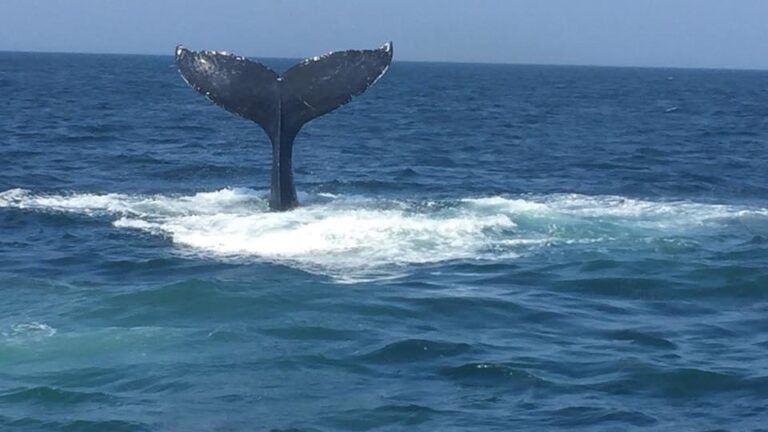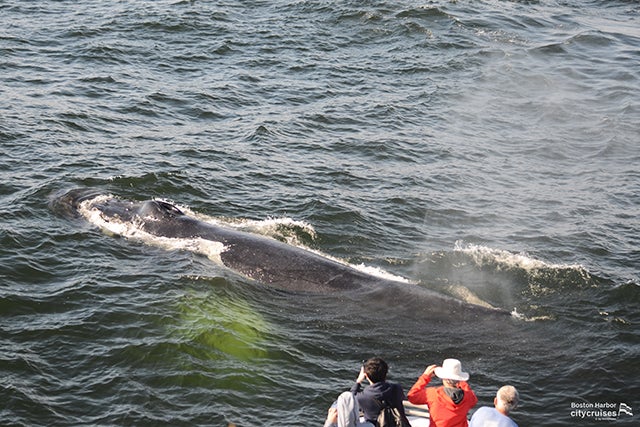Everything to know about going on a whale watch
Boston whale watch excursions run from March to November.

About 1 million people go whale watching each year across New England, according to Laura Howes, top naturalist for New England Aquarium Whale Watch in partnership with Boston Harbor City Cruises.
There are many opportunities for whale watching across Massachusetts, in destinations such as Boston, Cape Cod, Gloucester, New Bedford, Newburyport, and Plymouth, she said.
“Less than 100 years ago, whales were still being hunted. Now it’s a tourist operation to watch them and enjoy them,” Howes said. “So we should really appreciate that they’re still here and we get to see them in general.”
We asked Howes everything folks need to know about going on a whale watch. Here are a few things to keep in mind this season.
When is whale watch season?
Howes: For the majority of boats, it’s typically May through October. In Boston, though, we have a little bit longer of a season. We start the end of March, and we go all the way through the middle of November.
Where’s the best place to find whales?
Howes: The most activity tends to be the Stellwagen Bank National Marine Sanctuary. It’s a sanctuary grounds about 800 square miles and it’s 21 miles long. So it’s a long kind of narrow plateau under the water and that’s kind of right in the middle of Massachusetts Bay, about 20 to 30 miles from Boston.
What makes Stellwagen such a prime whale watching spot?
About 15,000 years ago, glaciers produced a big cut of sandy kind of plateau under the water and that creates something called upwelling. So nutrients get rushed up to the surface and then you mix it with sunlight. There’s a lot of nutrients in cold water, which the Gulf of Maine — that’s the general area where we are — has. So that creates the perfect ecosystem for other prey to come. It brings the whales, wildlife, all sorts of sea birds. So it’s all about where they find food. Stellwagen Bank is a great place for them to find that food.
What do whales eat?
Howes: Particularly in Stellwagen, it tends to be the sand lance. It’s like an eel-like fish. It’s also called a sand eel. There are other types of prey, but sand lance is one of the keystone species at Stellwagen Bank.
How much do they eat?
Howes: A humpback whale [which is the size of a school bus, Howes said] will eat about 500,000 to 1 million calories a day. So a couple tons of sand lance a day, if not more. That’s what they are aiming to eat.
Which type of whales are people going to see on a Massachusetts whale watch?
Howes: Typically, we’ll see the humpback whale. That’s probably the most common species. Where we are in the Gulf of Maine, there’s about 1,000 well- known humpbacks, and we’ll see anywhere from 200 to 400 different individuals throughout a summer at Boston Harbor City Cruises.
We’ll see the fin whale. There’s also the minke whale. In the springtime, we do occasionally see the North Atlantic right whale. They’re federally protected, so we stay 500 yards away from them just to give them extra space. And the sei whale. The last few years, we’ve been seeing more of those. We also see different species of toothed whales, so Atlantic white-sided dolphins, occasionally common dolphins, harbor porpoises, and seals as well.
What should folks bring on a whale watch?
Howes: If you’re coming on a whale watch, no matter what time of the year, it’s always going to be about 20 degrees colder when you’re offshore. So if it’s a hot summer day, make sure you bring some sort of jacket. In the spring and fall, it’s like winter when you’re out there. So bring lots of layers. You want to bring sunscreen, a hat, and comfortable shoes. And seasickness medication, if that is something that affects you. If you’re worried, a good rule of thumb is take it an hour before your cruise so it’s in your system. Also, a camera with a lens rather than just a cell phone because the whales are large but we keep a safe distance away, so a camera with an actual lens is really helpful.

What else is good to know?
Howes: It takes three to four hours. We do have a snack bar. There’s food and water on the boat. You can bring food for yourself, too, if you want. And there’s restrooms.
What is considered an excellent day of whale watching?
Howes: It’s always a hard question because every day on the water is always very different. That’s why I particularly like the job, because you never know what you’ll see. I would say if you had a perfect whale watch, it would be seeing different types of behaviors, different individual whales, or maybe different species. They’re not there to perform, so a breach — where they jump in front of you — is an amazing sight. They only do that about 10 percent of the time. Getting to see them in their natural habitat, feeding for sand lance. I think just seeing them in their natural environment.
What does breach mean?
Howes: A breach is where part or sometimes all of the whale’s body comes out of the water. Again, it’s not a very common behavior. And we don’t even know exactly why they do it. We do think it might be a way to communicate or knock off barnacles and whale lice. It could also just be fun. You’ll see young whales doing it, so it could be a way to learn how to play, learn how to move their body. And it takes a lot of energy. If you’re a 40-ton whale, you weigh about 12 elephants in weight — that takes a lot of energy to throw yourself out of the water. So it’s very interesting and perplexing why they do it. Sometimes they’ll slap their flippers, they’ll slap their tail. There’s a variety of what we call surface behaviors.
What else might people see?
Howes: The majority of time they are feeding or looking for food. But they’re mammals like us, so they still have to always come up to breathe at the surface. So luckily, especially at Stellwagen, we see whale sightings about 95 percent of the time. So every time they come up to breathe, you’ll see them exhaling. That’s that spout that you’ll see. That’s just their breath condensing to form a mist. Basically, they’re sticking the very top of their head out of the water so they can breathe. So that’s a very consistent sight.
And then some species, like the humpback, they have those big, long flippers and big round stomach. They have to lift their tail out of the water when they dive, so we call that fluking. So you almost always see the fluke of the humpback as they dive. Some species, like the fin whale, are more streamlined. They’re not bulky so they don’t need to lift the tail. But you will see them lift their back and arch that out of the water.
What happens if folks don’t see anything?
Howes: In the very small chance that you don’t see anything, we do offer a raincheck. It’s a voucher to come back anytime in the future and try again. It never expires, which is nice.
This interview has been lightly edited for clarity.









Conversation
This discussion has ended. Please join elsewhere on Boston.com